Study on the Optimal Volume Fracturing Design for Horizontal Wells in Tight Oil Reservoirs
Abstract
1. Introduction
2. Numerical Model Establishment
2.1. Basic Governing Equation
2.2. Production Model Establishment and Validation
2.2.1. Production Model Estabilshment
2.2.2. Production Model Validation
3. Results and Discussion
3.1. Optimization of Fracture Parameters
3.2. Optimization of Fracture Placement
3.2.1. Single Horizontal Well
3.2.2. Dual Branch Horizontal Well
4. Conclusions
Author Contributions
Funding
Institutional Review Board Statement
Informed Consent Statement
Data Availability Statement
Conflicts of Interest
References
- Wang, W.Q. Fluid Chemistry, Drilling and Completion; Oil and Gas Chemistry Management Series; Gulf Professional Publishing: Houston, TX, USA, 2021. [Google Scholar]
- Ma, X.; Hao, R.F.; Lai, X.A.; Zhang, Y.M.; Ma, Z.G.; He, M.F.; Xiao, Y.X.; Bi, M.; Ma, X.X. Field test of volume fracturing for horizontal wells in Sulige tight sandstone gas reservoirs. Pet. Explor. Dev. 2014, 41, 810–816. [Google Scholar] [CrossRef]
- Yu, L.; Wang, J.J.; Wang, C.; Chen, D. Enhanced Tight Oil Recovery by Volume Fracturing in Chang 7 Reservoir: Experimental Study and Field Practice. Energies 2019, 12, 2419. [Google Scholar] [CrossRef]
- Zhao, H.; Li, W.; Pu, H.; Yang, K.H. Formation Applicability Analysis of Stimulated Reservoir Volume Fracturing and Case Analysis. Petroleum 2021, 7, 160–167. [Google Scholar] [CrossRef]
- Wang, C.; He, S.B.; Wang, M.Y.; Xue, F.F. Density cutting volume fracturing technology for horizontal wells in the ultra-low permeability reservoirs: A case study of the Yuan284 area in the Huaqing oilfield Ordos Basin, China. Arab. J. Geosci. 2022, 15, 1409. [Google Scholar]
- Wu, Q.; Xu, Y.; Wang, X.Q.; Wang, T.F.; Zhang, S.L. Volume fracturing technology of unconventional reservoirs: Connotation, design optimization and implementation. Pet. Explor. Dev. 2012, 39, 377–384. [Google Scholar] [CrossRef]
- Ma, J.J.; Chen, J.J.; Chen, W.X.; Huang, L.C. A coupled thermal-elastic-plastic-damage model for concrete subjected to dynamic loading. Int. J. Plas. 2022, 153, 103279. [Google Scholar] [CrossRef]
- Mayerhofer, M.J.; Lolon, E.P.; Youngblood, J.E.; Heinze, J.R. Integration of Microseismic Fracture Mapping Results with Numerical Fracture Network Production Modeling in the Barnett Shale. In Proceedings of the SPE Annual Technical Conference and Exhibition, San Antonio, TX, USA, 24–27 September 2006. [Google Scholar]
- Hughes, D.J. A reality check on the shale revolution. Nature 2013, 494, 307–308. [Google Scholar] [CrossRef]
- Jiang, Z.L.; Qiu, H.J.; Huang, Y.P.; Jiang, K.P.; Fu, W.K.; Chen, J. Lacustrine Source Rocks of Middle Jurassic in Southeast Depression in Tarim Basin. Xinjiang Pet. Geol. 2013, 34, 1. Available online: http://www.zgxjpg.com/EN/Y2013/V34/I6/1 (accessed on 17 November 2022).
- Zhang, Q.S.; Li, M.; Zhang, Z.L.; Chen, Y.; Zhang, L.Y.; Li, A.S. Application of volume fracturing technology in tight oil reservoirs of Shengli oilfield. China Pet. Explor. 2019, 24, 233–240. [Google Scholar] [CrossRef]
- Mayerhofer, M.J.; Lolon, E.P.; Warpinski, N.R.; Cipolla, C.L.; Walser, D.; Rightmire, C.M. What Is Stimulated Reservoir Volume? SPE Prod. Oper. 2010, 25, 89–98. [Google Scholar] [CrossRef]
- Kolawole, O.; Esmaeilpour, S.; Hunky, R.; Saleh, L.; Ali-Alhaj, H.K.; Marghani, M. Optimization of Hydraulic Fracturing Design in Unconventional Formations: Impact of Treatment Parameters. In Proceedings of the SPE Kuwait Oil & Gas Show and Conference, Kuwait City, Kuwait, 13–16 October 2019. [Google Scholar]
- Wang, H.Y.; Zhou, D.S.; Liu, S.; Wang, X.X.; Ma, X.L.; Yao, T.Q. Hydraulic fracture initiation for perforated wellbore coupled with the effect of fluid seepage. Energy Rep. 2022, 8, 10290–10298. [Google Scholar] [CrossRef]
- Bazan, L.W.; Larkin, S.D.; Lattibeaudiere, M.G.; Terry, T.P. Improving Production in the Eagle Ford Shale with Fracture Modeling, Increased Conductivity and Optimized Stage and Cluster Spacing along the Horizontal Wellbore. In Proceedings of the Tight Gas Completions Conference, San Antonio, TX, USA, 2–3 November 2010. [Google Scholar]
- Roussel, N.P.; Sharma, M.M. Optimizing Fracture Spacing and Sequencing in Horizontal-Well Fracturing. SPE Prod. Oper. 2011, 26, 173–184. [Google Scholar] [CrossRef]
- Jabbari, H.; Zeng, Z.W. Hydraulic Fracturing Design for Horizontal Wells in the Bakken Formation. In Proceedings of the 46th U.S. Rock Mechanics/Geomechanics Symposium, Chicago, IL, USA, 24–27 June 2012. [Google Scholar]
- Yu, W.; Sepehrnoori, K. An efficient reservoir-simulation approach to design and optimize unconventional gas production. J. Canadian Pet. Technol. 2014, 53, 109–121. [Google Scholar] [CrossRef]
- Al-Fatlawi, O.; Hossain, M.; Essa, A. Optimization of Fracture Parameters for Hydraulic Fractured Horizontal Well in a Heterogeneous Tight Reservoir: An Equivalent Homogeneous Modelling Approach. In Proceedings of the SPE Kuwait Oil & Gas Show and Conference, Kuwait City, Kuwait, 13–16 October 2019. [Google Scholar]
- Shirbazo, A.; Fahimpour, J.; Aminshahidy, B. A new approach to finding effective parameters controlling the performance of multi-stage fractured horizontal wells in low-permeability heavy-oil reservoirs using RSM technique. J Pet. Explor. Prod. Technol. 2020, 10, 3569–3586. [Google Scholar] [CrossRef]
- Zhao, J.; Zhao, J.Z.; Hu, Y.G.; Zhang, S.A.; Huang, T.; Liu, X.J. Numerical simulation of multistage fracturing optimization and application in coalbed methane horizontal wells. Eng. Fract. Mech. 2020, 223, 106738. [Google Scholar] [CrossRef]
- Kolawole, O.; Wigwe, M.; Ispas, I.; Watson, M. How will treatment parameters impact the optimization of hydraulic fracturing process in unconventional reservoirs? SN Appl. Sci. 2020, 2, 1865. [Google Scholar] [CrossRef]
- Wang, H.Z.; Zhao, Z.M.; Zhu, J.; Diao, C.J.; Yang, Y.T. Fracture Parameters Optimization of Horizontal Well Volume Fracturing in Ma18 Block. Solid State Technol. 2020, 63, 6188–6200. [Google Scholar]
- Holt, S. Numerical Optimization of Hydraulic Fracture Stage Placement in a Gas Shale Reservoir. Master’s Thesis, Deflt University of Technology, Deflt, The Netherlands, 2011. [Google Scholar]
- Wilson, K.C.; Durlofsky, L.J. Computational Optimization of Shale Resource Development Using Reduced-Physics Surrogate Models. In Proceedings of the SPE Western Regional Meeting, Bakersfield, CA, USA, 21–23 March 2012. [Google Scholar]
- Jahandideh, A.; Jafarpour, B. Optimization of hydraulic fracturing design under spatially variable shale fracability. J. Pet. Sci. Eng. 2016, 138, 174–188. [Google Scholar] [CrossRef]
- Safari, R.; Lewis, R.; Ma, X.D.; Mutlu, U.; Ghassemi, A. Infill-Well Fracturing Optimization in Tightly Spaced Horizontal Wells. SPE J. 2017, 22, 582–595. [Google Scholar] [CrossRef]
- Shahkarami, A.; Wang, G.C. Horizontal Well Spacing and Hydraulic Fracturing Design Optimization: A Case Study on Utica-Point Pleasant Shale Play. J. Sus. Energy Eng. 2019, 5, 148–162. [Google Scholar] [CrossRef]
- He, Y.W.; Cheng, S.Q.; Li, S.; Huang, Y.; Qin, J.Z.; Hu, L.M.; Yu, H.Y. A Semianalytical Methodology To Diagnose the Locations of Underperforming Hydraulic Fractures Through Pressure-Transient Analysis in Tight Gas Reservoir. SPE J. 2016, 22, 924–939. [Google Scholar] [CrossRef]
- Peshcherenko, A.; Bekerov, I.; Chuprakov, D.; Abdrazakov, D. Fast-running model for high-volume hydraulic fracturing. J. Pet. Sci. Eng. 2022, 213, 110430. [Google Scholar] [CrossRef]
- Deng, H.Y.; Sheng, G.L.; Zhao, H.; Meng, F.K.; Zhang, H.Y.; Ma, J.L.; Gong, J.; Ruan, J.Y. Integrated optimization of fracture parameters for subdivision cutting fractured horizontal wells in shale oil reservoirs. J. Pet. Sci. Eng. 2022, 212, 110205. [Google Scholar] [CrossRef]
- Huang, L.C.; Liang, J.G.; Ma, J.J.; Chen, W.X. A dynamic bounding surface plasticity damage model for rocks subjected to high strain rates and confinements. Int. J. Impact Eng. 2022, 168, 104306. [Google Scholar] [CrossRef]
- Ma, J.J.; Zhao, G.F.; Khalili, N. A fully coupled flow deformation model for elasto-plastic damage analysis in saturated fractured porous media. Int. J. Plast. 2016, 76, 29–50. [Google Scholar] [CrossRef]
- Xia, D.B.; Yang, Z.M.; Li, D.L.; Zhang, Y.P.; Zhao, X.L.; Yao, L.L. Research on numerical method for evaluation of vertical well volume fracturing effect based on production data and well test data. J Pet. Explor. Prod. Technol. 2021, 11, 1855–1863. [Google Scholar] [CrossRef]
- Ma, J.J. Wetting collapse analysis on partially saturated oil chalks by a modified cam clay model based on effective stress. J. Pet. Sci. Eng. 2018, 167, 44–53. [Google Scholar] [CrossRef]
- Aziz, K.; Settari, A. Petroleum Reservoir Simulation; Elsevier: Houston, TX, USA, 1979. [Google Scholar]
- Zhang, G.M.; Liu, H.; Zhang, J.; Wu, H.A.; Wang, X.X. Three-dimensional finite element simulation and parametric study for horizontal well hydraulic fracture. J. Pet. Sci. Eng. 2010, 72, 310–317. [Google Scholar] [CrossRef]
- Peter, P.V.; Lee, W.J. A Better Way to Forecast Production from Unconventional Gas Wells. In Proceedings of the SPE Annual Technical Conference and Exhibition, Florence, Italy, 19–22 September 2010. [Google Scholar]
- Wang, H.Y.; Zhou, D.S.; Gao, Q.; Fan, X.; Xu, J.Z.; Liu, S. Study on the Seepage Force-Induced Stress and Poroelastic Stress by Flow Through Porous Media Around a Vertical Wellbore. Int. J. Appl. Mech. 2021, 13, 2150065. [Google Scholar] [CrossRef]
- Muther, T.; Aftab, A.; Ismail, A.I. Analysis on the effect of different fracture geometries on the productivity of tight gas reservoirs. Malay. J. Fundam. Appl. Sci. 2020, 16, 201–211. [Google Scholar] [CrossRef]
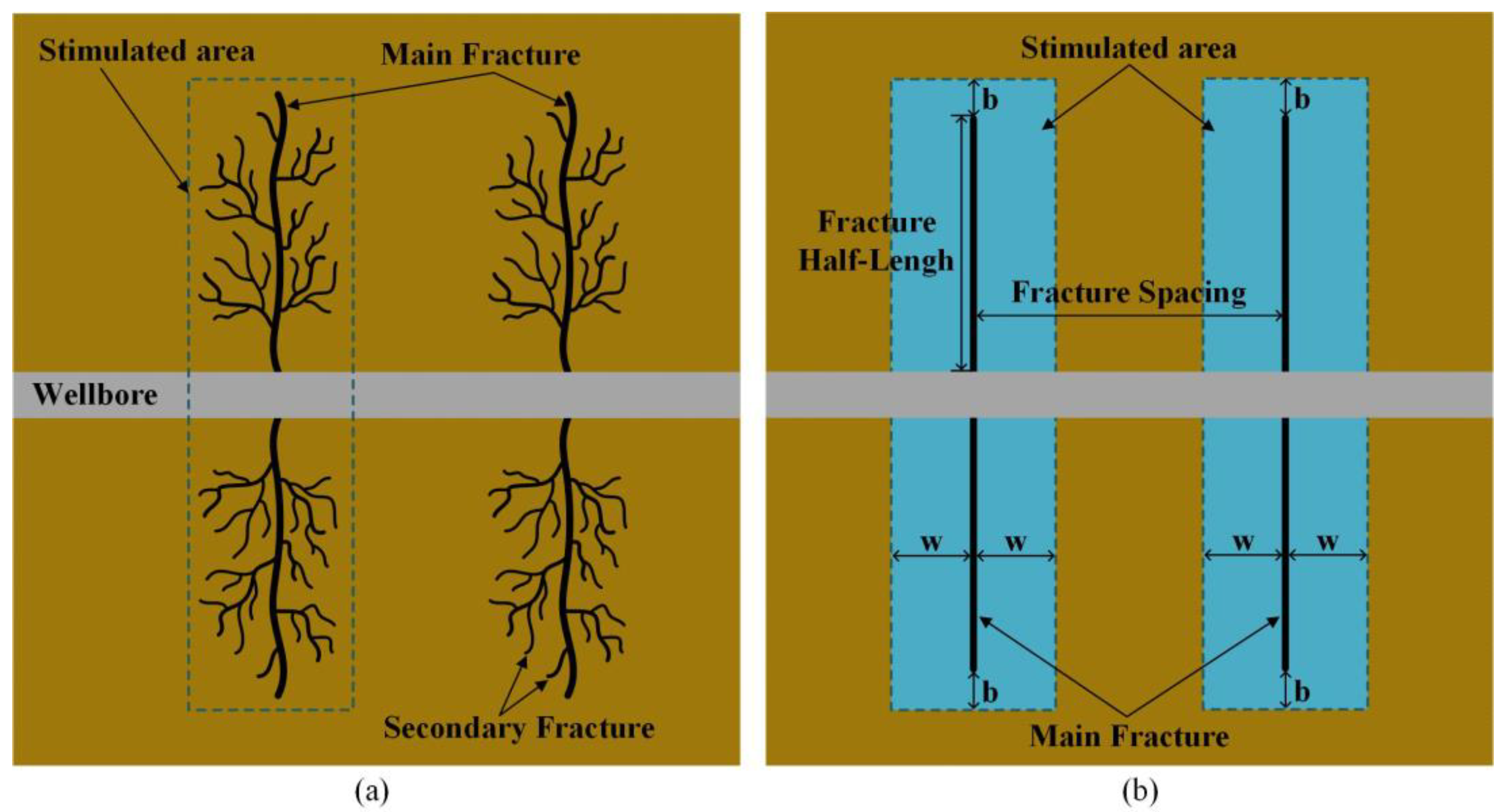
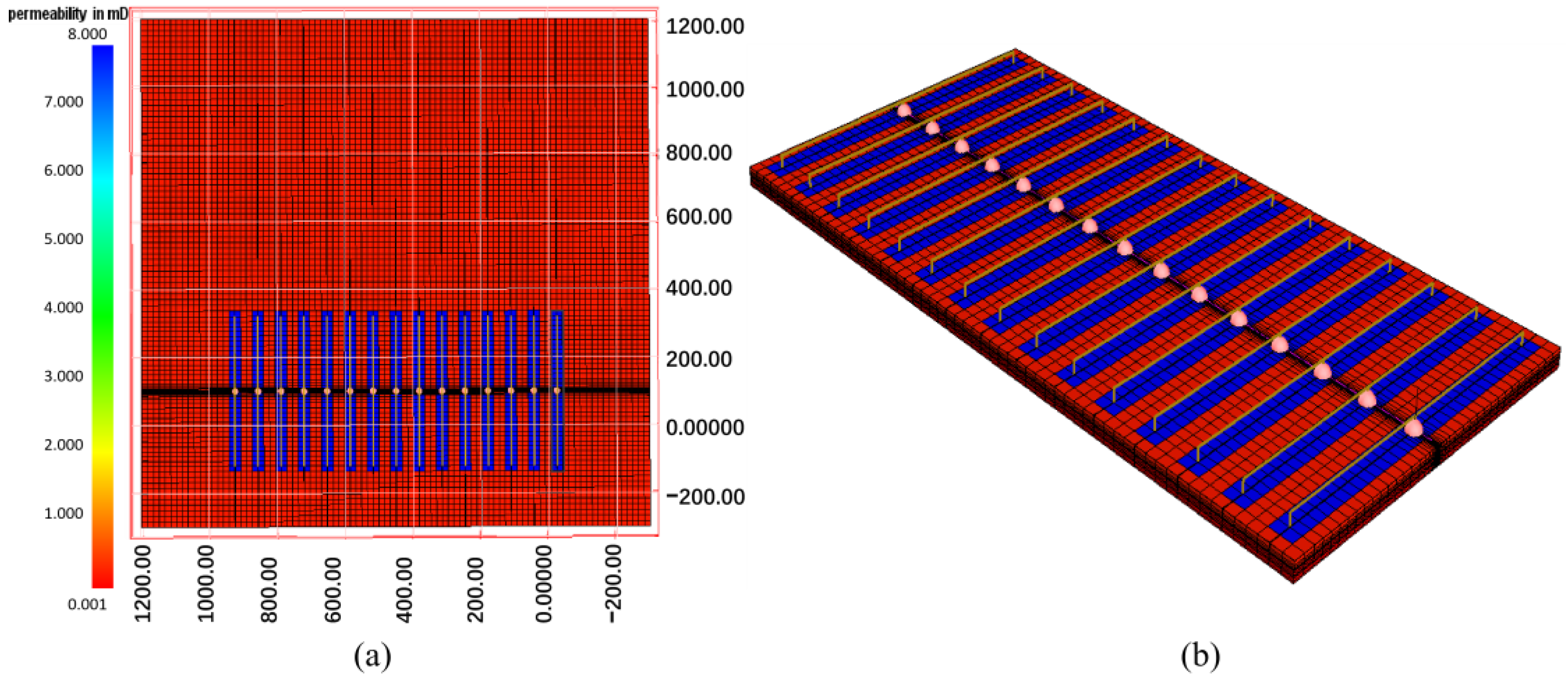
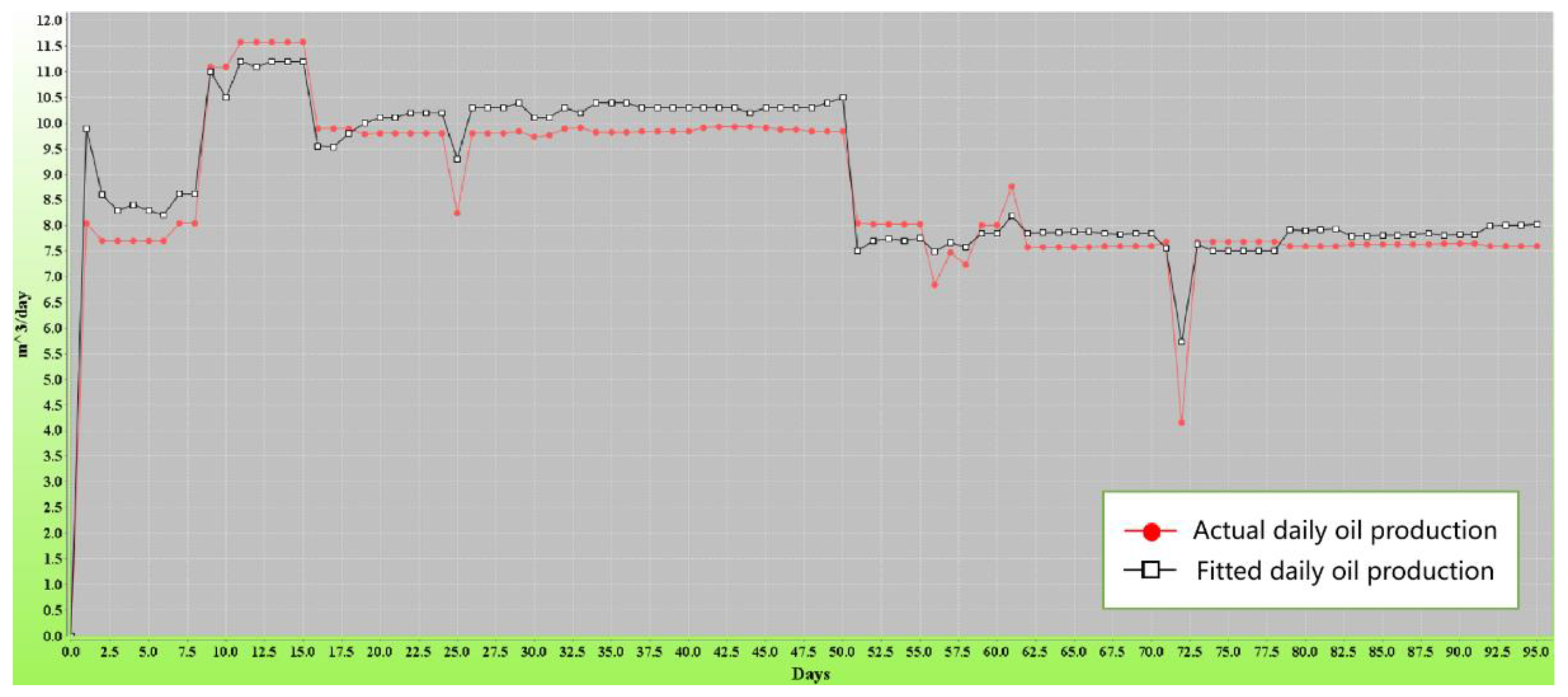
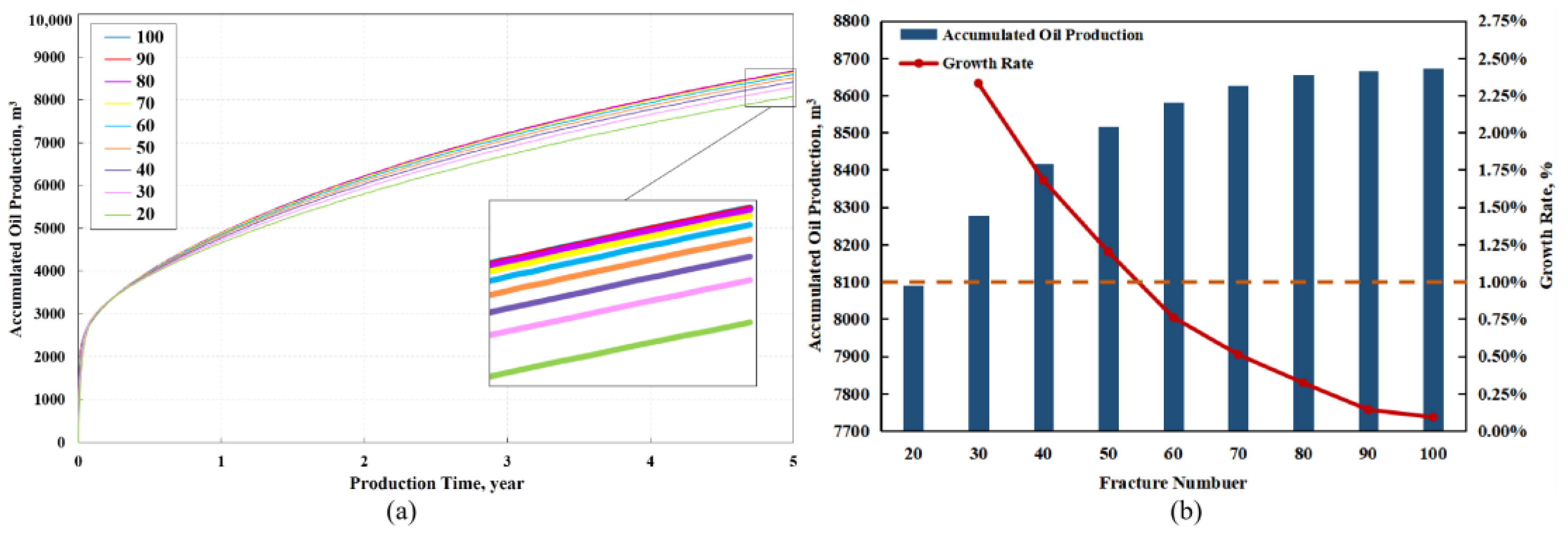

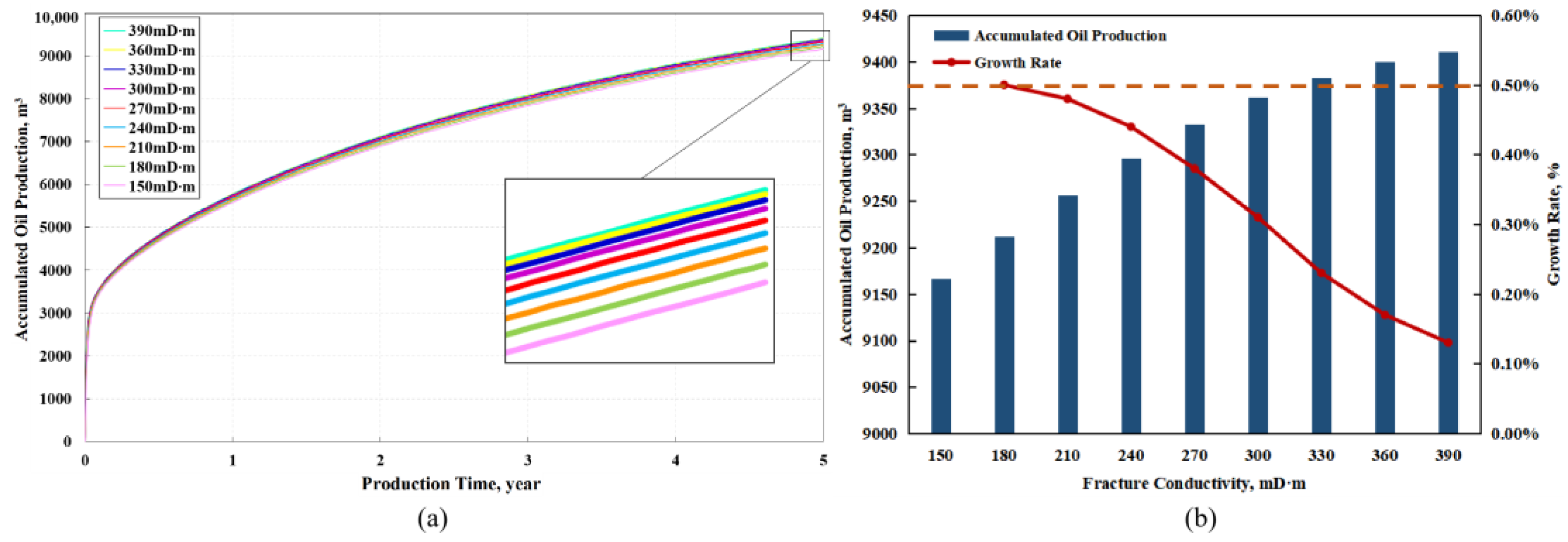
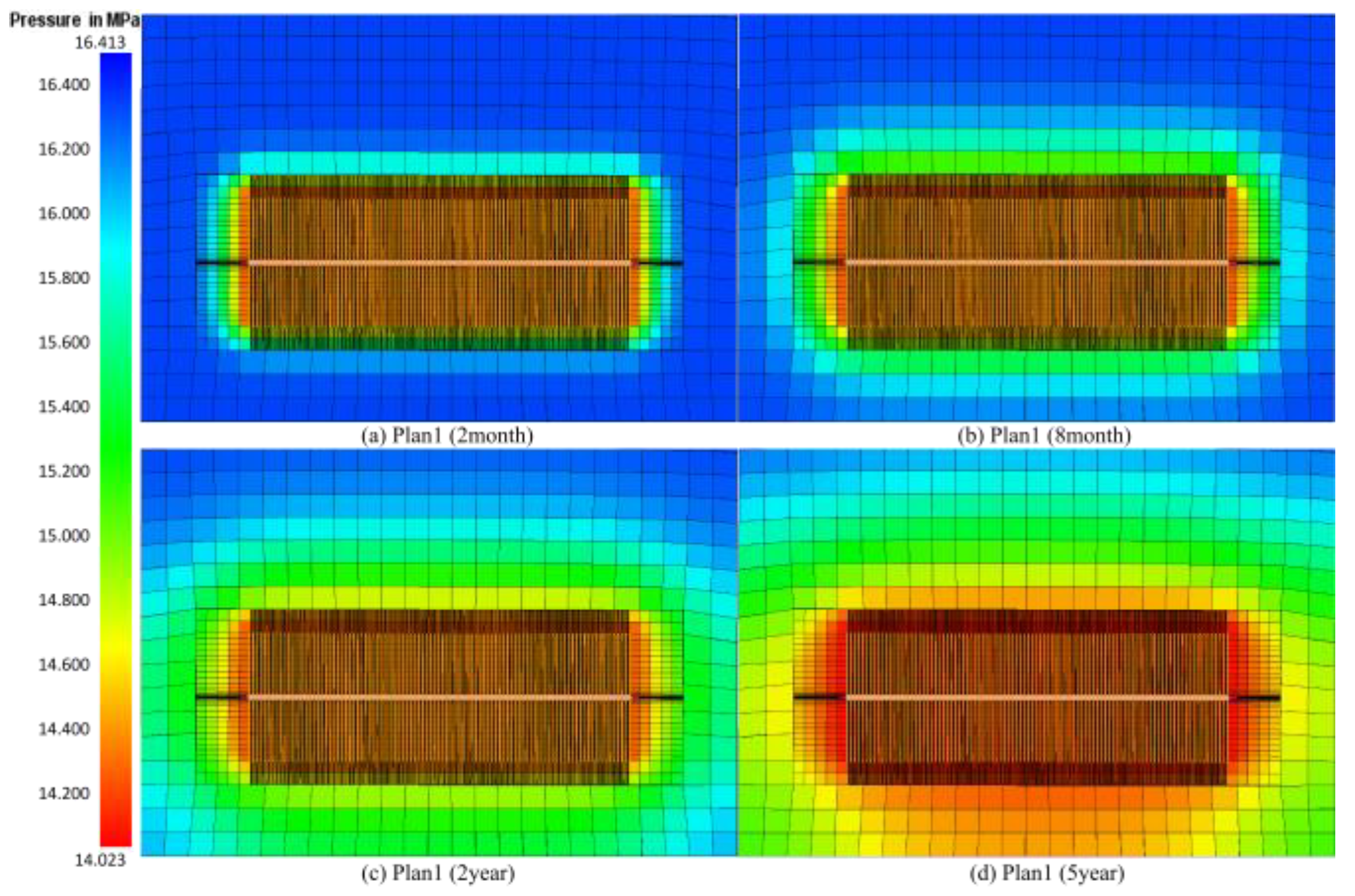

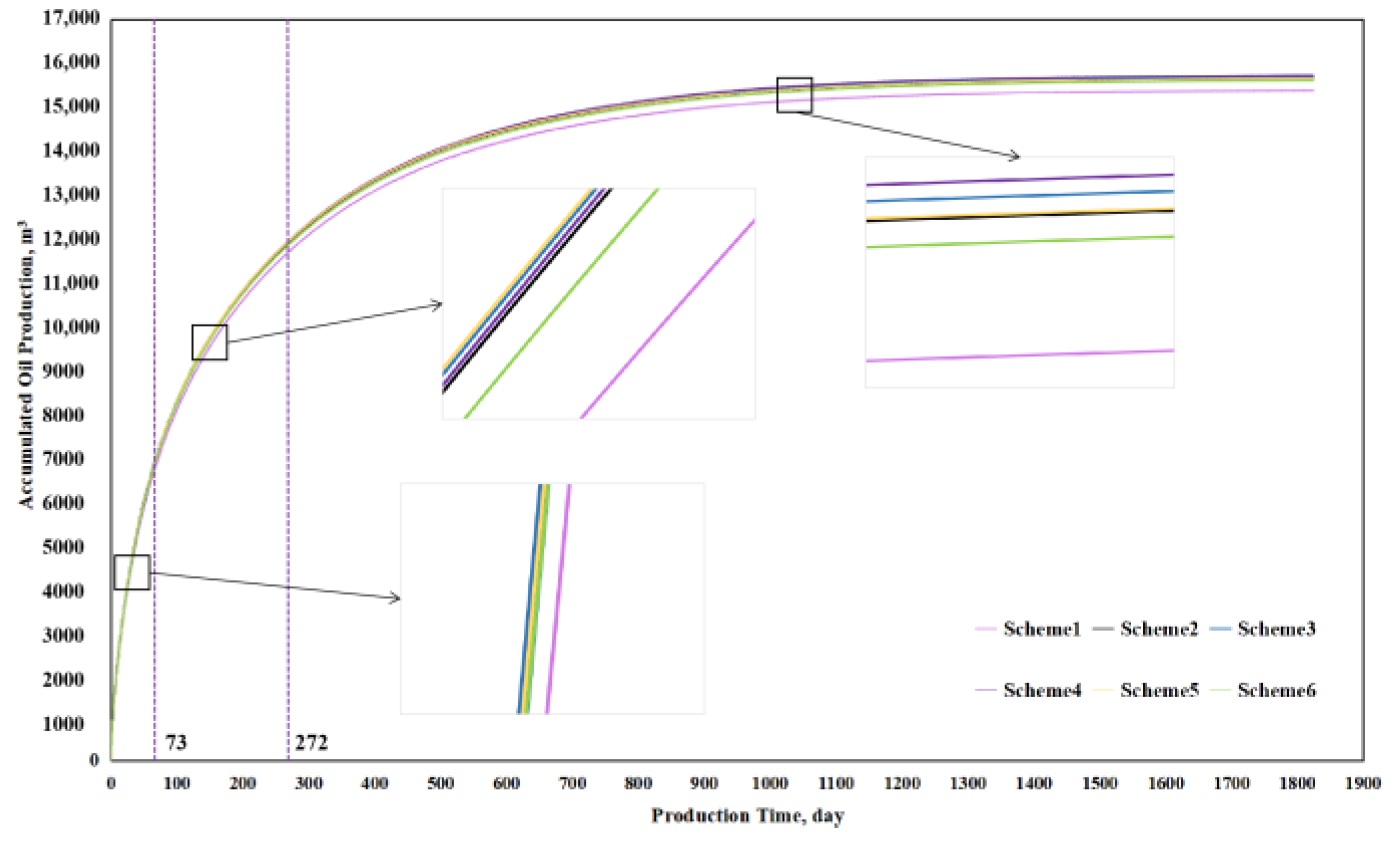
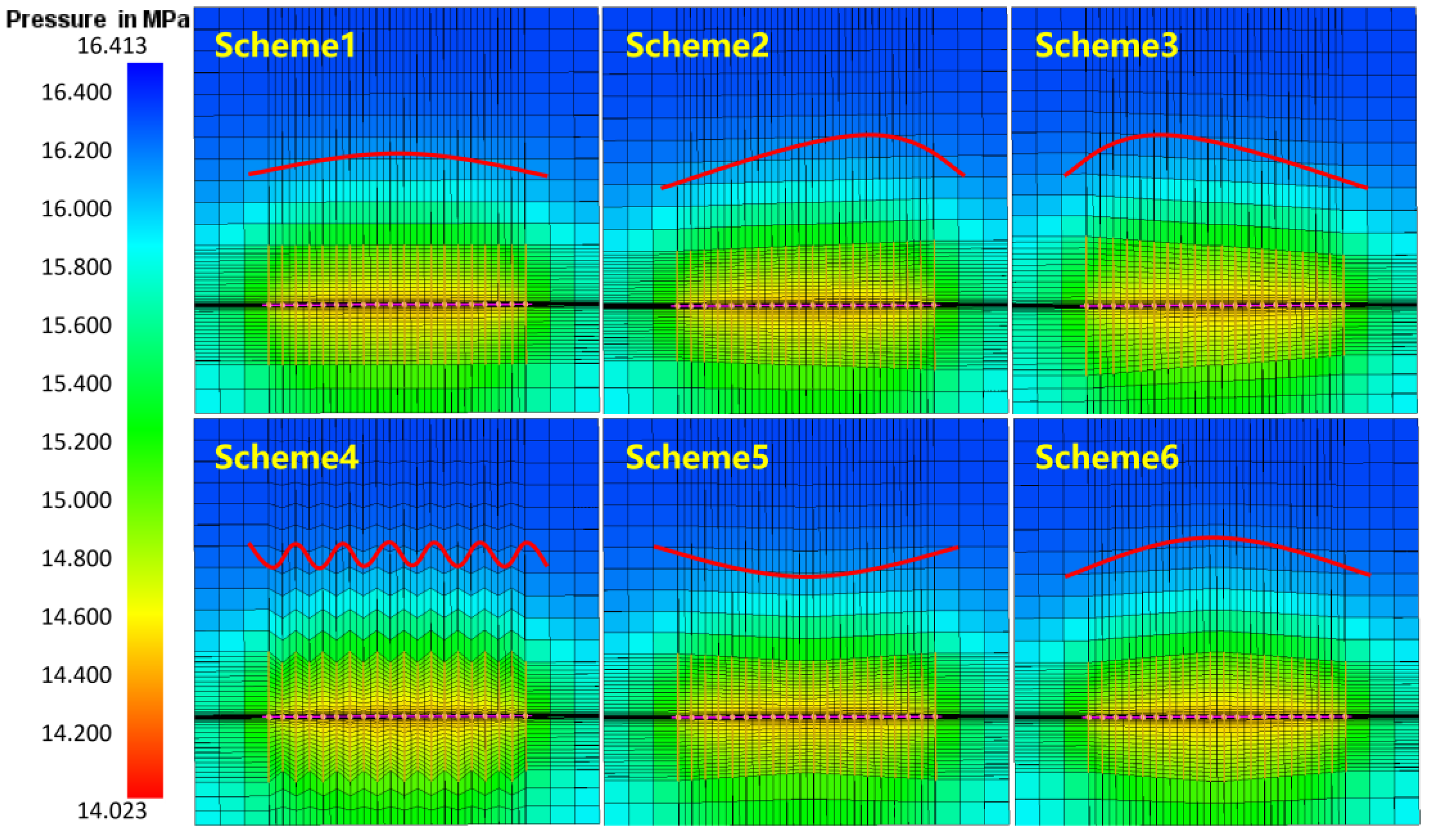
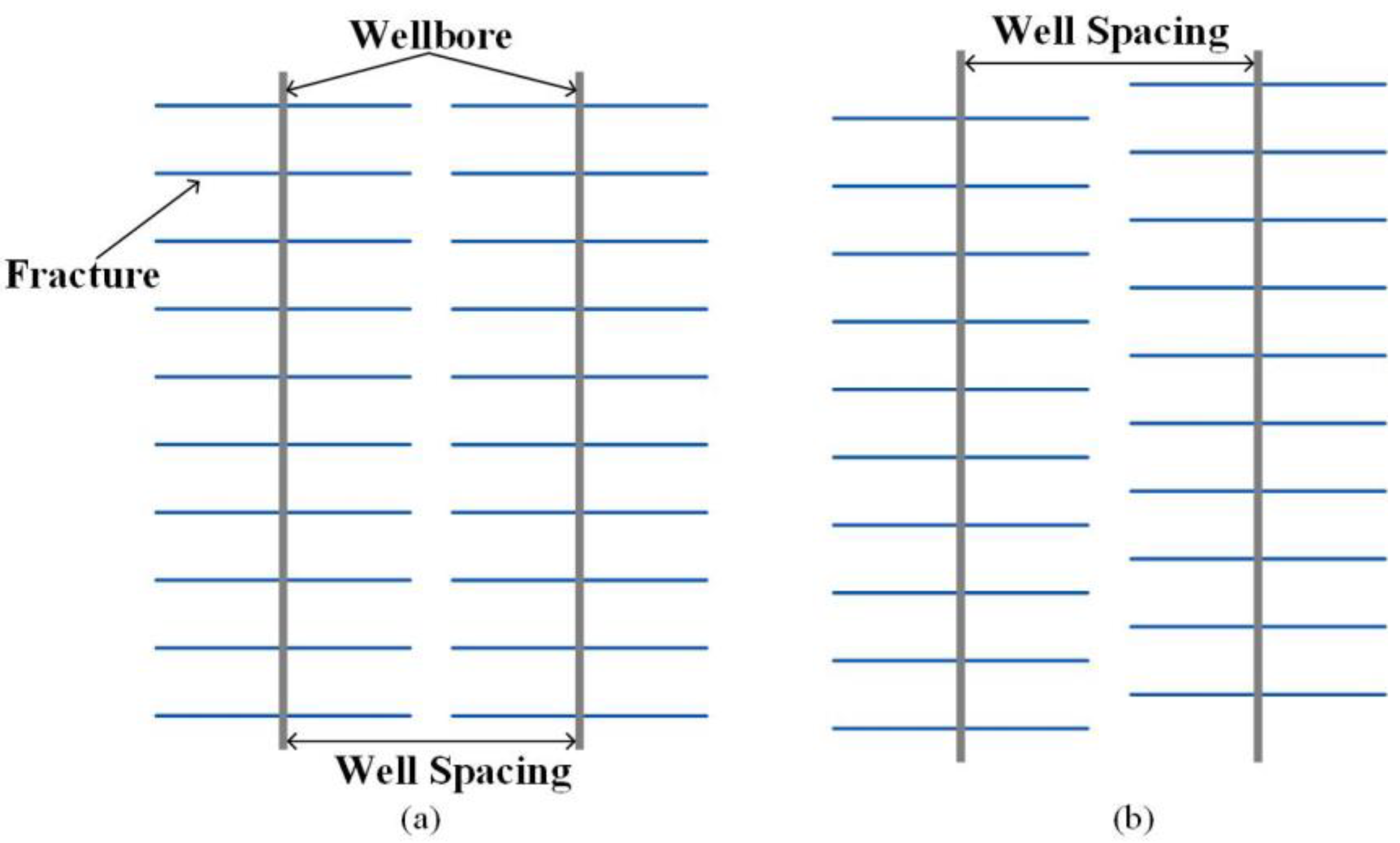
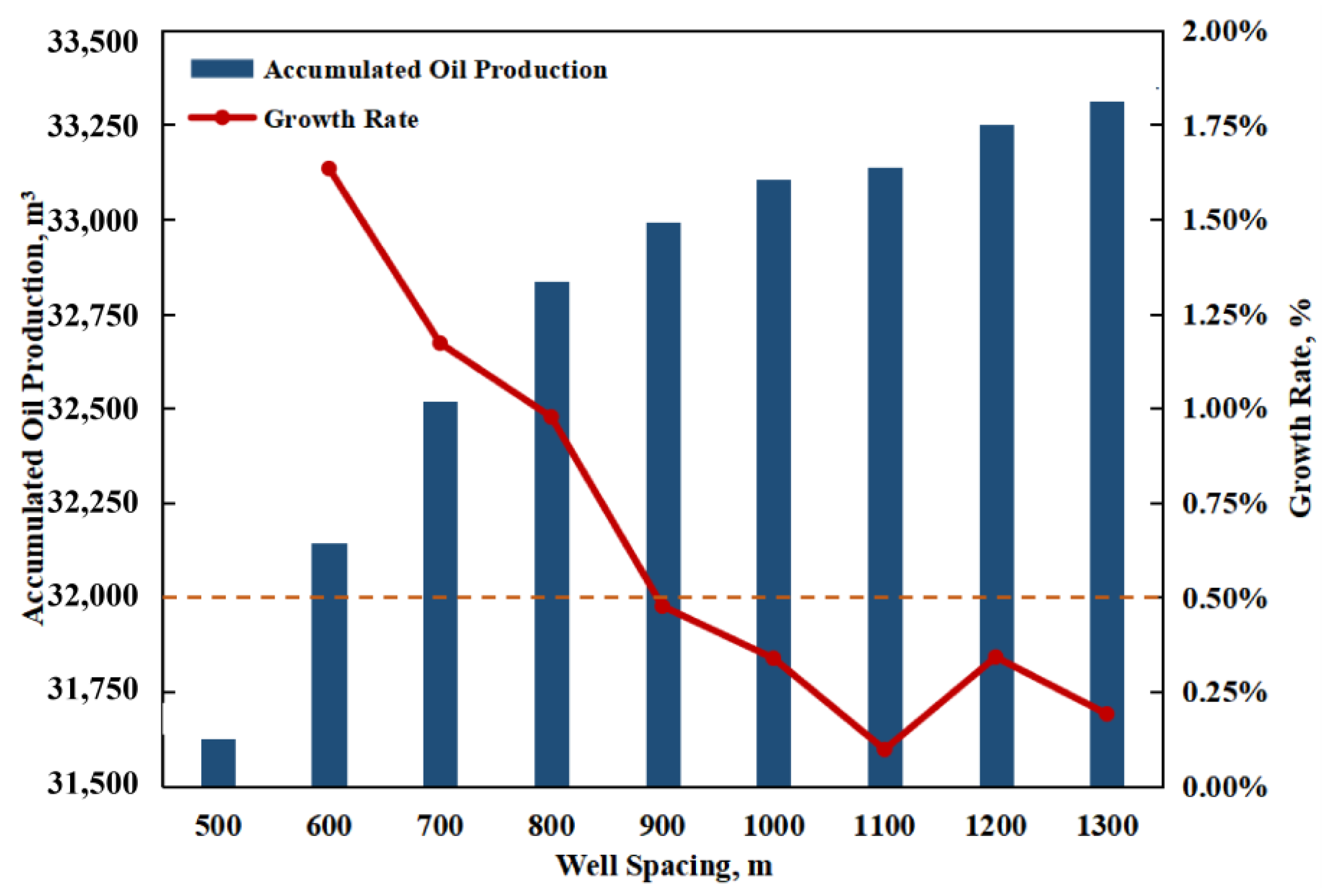
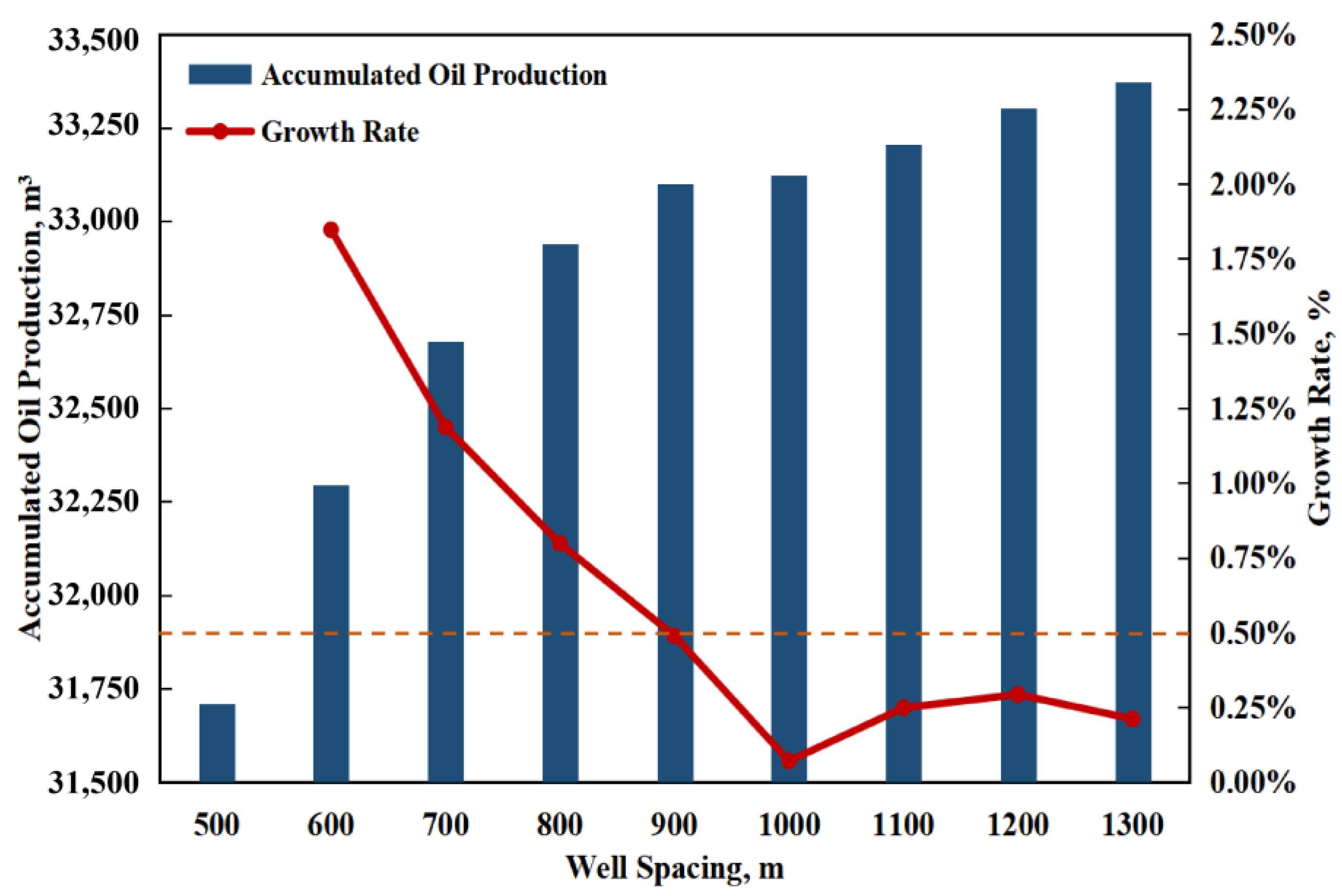
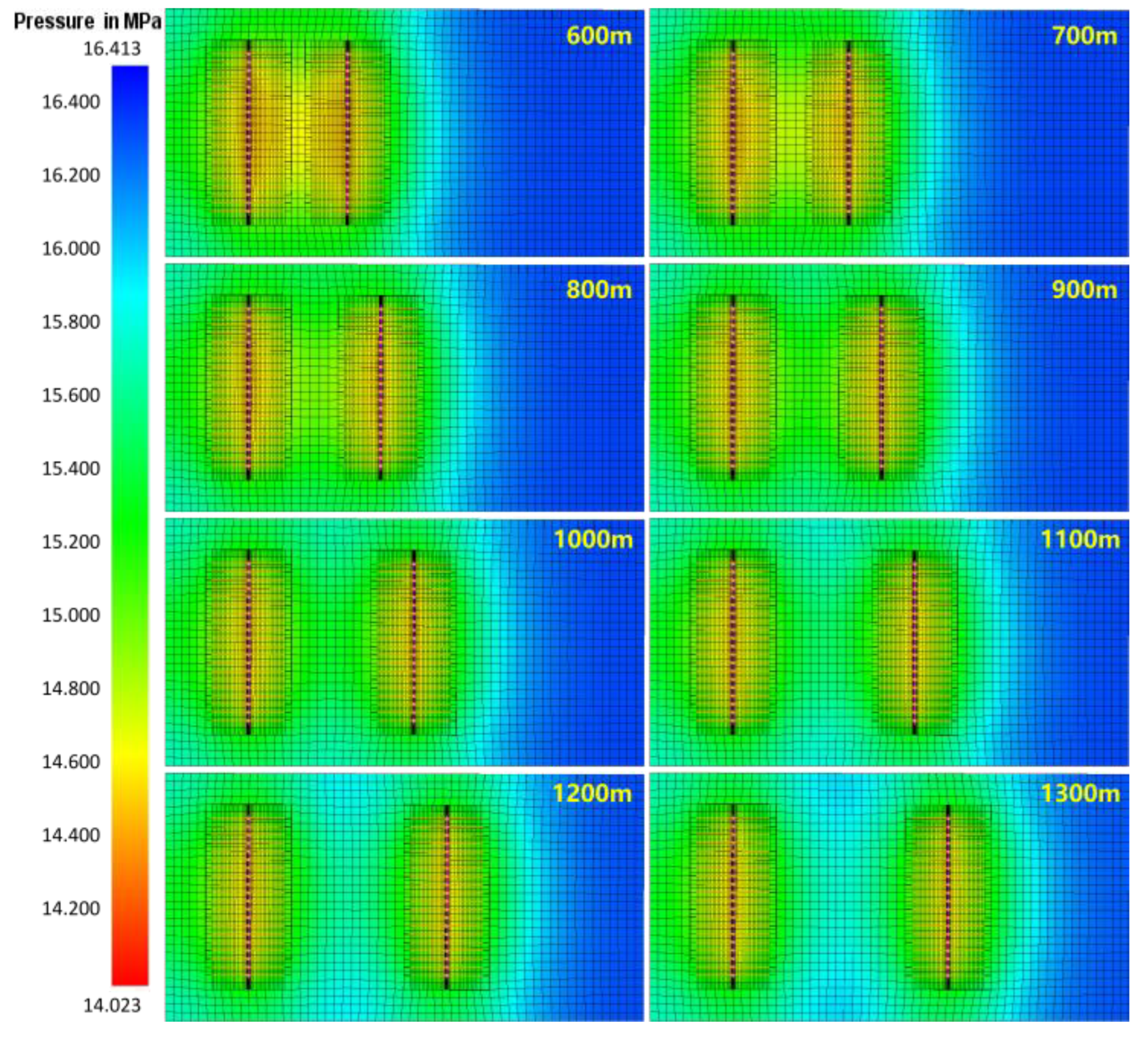
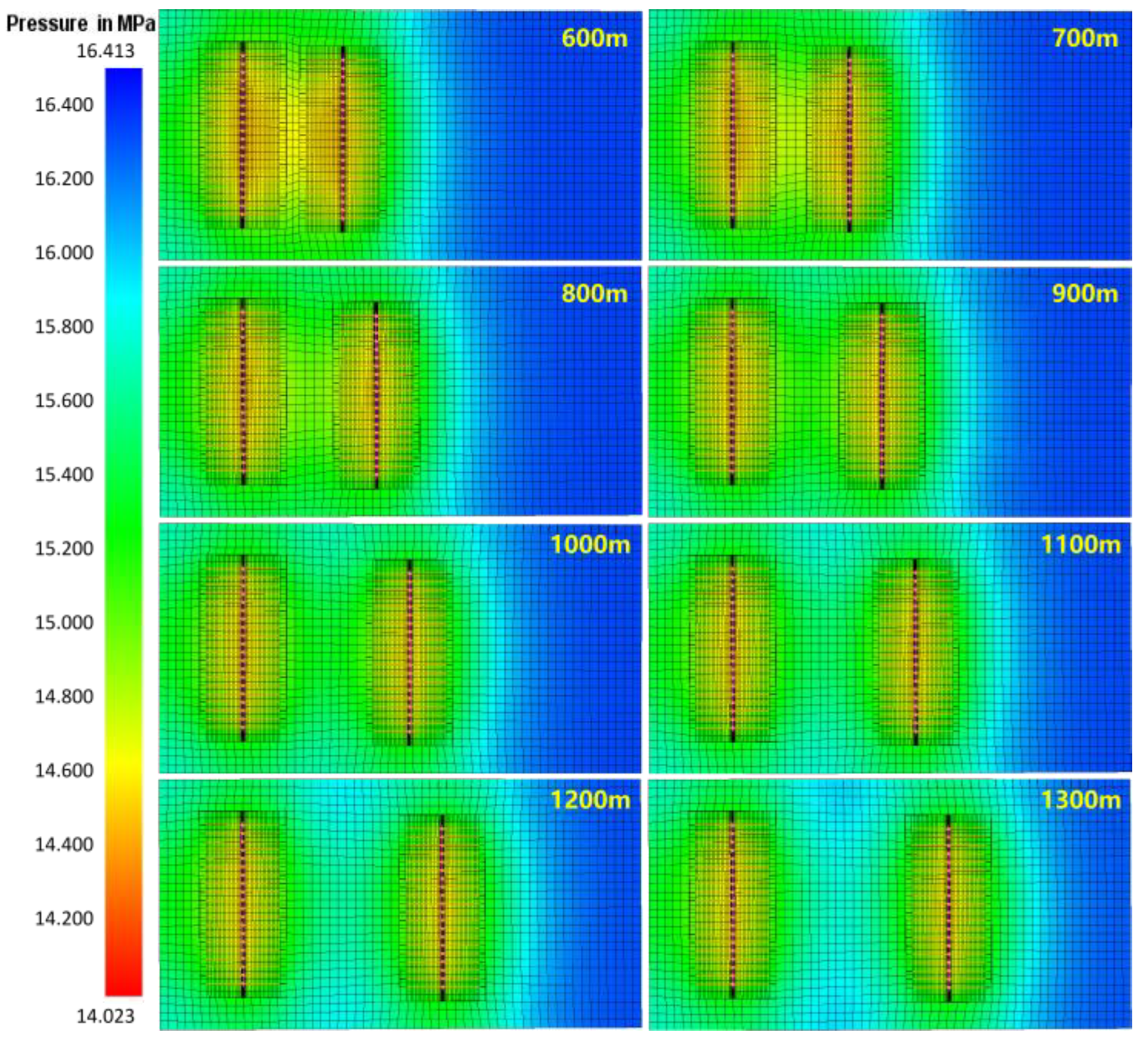
| Fitting Parameter | Well JW-1 | Fracture Parameter | Well JW-1 |
|---|---|---|---|
| Reservoir effective thickness (m) | 16.5 | Horizontal well length (m) | 1000 |
| Reservoir average porosity (%) | 10.2 | Fracture number | 20 |
| Reservoir permeability (mD) | 0.21 | Fracture half-length (m) | 160 |
| Crude oil density (g/cm3) | 0.84 | Fracture height (m) | 30 |
| Reservoir pressure (MPa) | 16.21 | Fracture width (mm) | 15 |
| Drainage area (km2) | 0.823 | Fracture permeability (mD) | 20,000 |
| Dimensionless reservoir aspect ratio | 0.667 | Fracture conductivity (mD·m) | 300 |
| Total reservoir compression coefficient (MPa−1) | 5.45 × 10−4 | Stimulated area bandwidth (m) | 50 |
| Equivalent reservoir viscosity (cp) | 1.5 | Stimulated area effective permeability (mD) | 8 |
| Temperature (°C) | 59.0 |
Publisher’s Note: MDPI stays neutral with regard to jurisdictional claims in published maps and institutional affiliations. |
© 2022 by the authors. Licensee MDPI, Basel, Switzerland. This article is an open access article distributed under the terms and conditions of the Creative Commons Attribution (CC BY) license (https://creativecommons.org/licenses/by/4.0/).
Share and Cite
Jie, Y.; Yang, J.; Zhou, D.; Wang, H.; Zou, Y.; Liu, Y.; Zhang, Y. Study on the Optimal Volume Fracturing Design for Horizontal Wells in Tight Oil Reservoirs. Sustainability 2022, 14, 15531. https://doi.org/10.3390/su142315531
Jie Y, Yang J, Zhou D, Wang H, Zou Y, Liu Y, Zhang Y. Study on the Optimal Volume Fracturing Design for Horizontal Wells in Tight Oil Reservoirs. Sustainability. 2022; 14(23):15531. https://doi.org/10.3390/su142315531
Chicago/Turabian StyleJie, Yenan, Jing Yang, Desheng Zhou, Haiyang Wang, Yi Zou, Yafei Liu, and Yanjun Zhang. 2022. "Study on the Optimal Volume Fracturing Design for Horizontal Wells in Tight Oil Reservoirs" Sustainability 14, no. 23: 15531. https://doi.org/10.3390/su142315531
APA StyleJie, Y., Yang, J., Zhou, D., Wang, H., Zou, Y., Liu, Y., & Zhang, Y. (2022). Study on the Optimal Volume Fracturing Design for Horizontal Wells in Tight Oil Reservoirs. Sustainability, 14(23), 15531. https://doi.org/10.3390/su142315531







